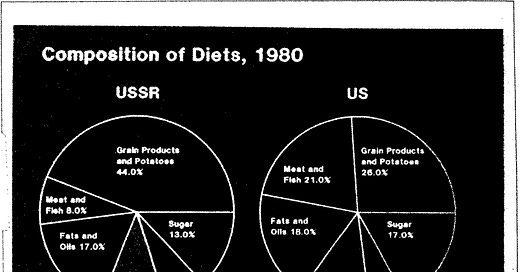

Discover more from That Great Fiction
Communists and socialists often argue that the Soviet Union had a better quality of life and well-being than America. One tactic they use to push this nonsense is citing a memo that can be found on the CIA website. The memo reads:
American and Soviet citizens eat about the same amount of food each but the Soviet diet may be more nutritious.
According to a CIA report released today (8 Jan, 1983)) both nationalities may be eatng too much for good health.
The CIA drew no conclusions about the nutritional makeup of the Soviet and American diets but commonly accepted U.S. health views suggest the Soviet diet may be slightly better.
According to Central Intelligence Agency, an average Soviet citizen consumes 3 280 calorious a day, compared to 3 520 calories for the American.
The average daily calorie intake in teh Soviet Union is: grain products and potates 44%; sugar 13%; dairy and eggs 11%; fats and oils 17%; meat and fish 8%; and other products 7%.
The american consumes daily: grain and potatoes 26%,; sugar 17%; dairy and eggs 12%; fats and oils 18%; meat and fish 21%; and other products 6%.
Americans eat more fish and more sugar, more dairy products and eggs, and more fats and oils and less grain the average Soviet citizen, and consumes more calories.
Generally held nutrional standards suggest individuals need fewer calories, less meat, less sugar and more grain to stay fit.
This one page seems very odd to me, not only because it is just one page, but also because it lacks actual data and methodology. Of course, this is a summary and not the actual report being referenced. So why don’t the communists cite the actual report? The full report doesn’t seem to present the same findings claimed in the memo. However, I did finally find the original data in Henry Rowen’s Soviet Food Self-Sufficiency, presented to the Joint Economic Committee.1
I wish communists were less lazy and actually bothered to track down the original data as I did, but let’s move on. Even if we disregard the fact that the Soviets required a much higher caloric intake to have the same level of comfort as Americans3 (harsher weather, younger population, and more brutal labor), there are still many problems with claiming that the Soviets ate better.
Trusting the CIA is very convenient for the communists due to the fact that the CIA frequently overestimated the Soviet economy and living conditions. Gertrude Schroeder, at the time an economist for the CIA, noted in 1966 that the CIA statistics on Soviet consumption “…undoubtedly overstate the relative position of the USSR because the calculations cannot allow adequately for the superior quality of U.S. products and the much greater variety and assortment products available here.”4
Economist Vladimir G. Treml examined the 3,280 calorie statistics directly in his paper, Soviet Foreign Trade in Foodstuffs. Treml pointed out that these statistics failed to account for many types of losses, largely due to the diversion of food products prior to human consumption. There are two major sources of this diversion: ( 1 ) bread and bakery products fed to livestock and ( 2 ) sugar, bread, and other foods used in the home production of moonshine and other alcoholic beverages. In Treml’s estimations, these two factors alone cause a loss of 200 calories per capita per day. This is before accounting for poor harvesting and distribution techniques.5
Former Soviet economist Igor Birman also directly responded to the 1982/83 CIA report in his book Personal Consumption in the USSR and USA in 1989. In his book, he criticizes the CIA’s methodology, reporting: “Both American and Soviet statistics differ therefore from the accounts of a national product and personal consumption. These differences hampered many of the authors' calculations. I refer to such cases in my analysis.”6 Birman’s final adjusted estimates claim Soviet citizens ate 43% of what Americans ate.7
Despite Birman’s hesitation to fully trust even his own data8, it was later revealed to be entirely correct. As John Howard Wilhelm noted in the journal Europe-Asia Studies, “Given what has happened and what we now know, Birman clearly did get it right.” He goes on to say, “some of the most 'advanced' techniques were used in studies of the Soviet economy….. But these techniques clearly did not perform as well as Birman's 'anecdotal economics' in getting the Soviet economic situation right.”9
You can read more about the Soviet Union’s food situation here.
Rowen, Henry, “Soviet Food Self-Sufficiency.” in Joint Economic Committee, US Congress, Allocation of Resources in the Soviet Union and China. (1982), pp. 262-264.
Ibid, p. 202.
Lunze, Karsten & Yurasova, Elena & Idrisov, Bulat & Gnatienko, Natalia & Migliorini, Luigi. “Food security and nutrition in the Russian Federation - A health policy analysis.” Global health action. 8. (2015)
Schroeder, Gertrude. "Soviet Reality Sans Potemkin." Studies in Intelligence 12, no. 2 (Spring 1968): 43-51. In Inside CIA's Private World: Declassified Articles from the Agency's Internal Journal, 1955-1992, ed. H. Bradford Westerfield, pp. 41-48.
Treml, Vladimir, “Soviet foreign trade in foodstuffs: a measure”, Center for International Research, Bureau of the Census, U.S. Dept. of Commerce (1986), pp. 8-12.
Birman, Igor. Personal Consumption in the USSR and USA (1989), p. 24.
Ibid, p. 71.
Ibid, p. 72.
Wilhelm, John Howard. “The Failure of the American Sovietological Economics Profession.” Europe-Asia Studies 55, no. 1 (2003), p. 59–74.
Subscribe to That Great Fiction
Economics, Politics, and Society. Takes and analysis inspired by the works of the Austro-Libertarians like Hans-Hermann Hoppe














Bootlickers will just say anything, even discrediting their own sources as wrong if they’re used against them. The actual document is 23 pages long and goes in detail about how they not only consume more calories in a given day but that they likely gain more nutrition from it. Read, seethe and cope